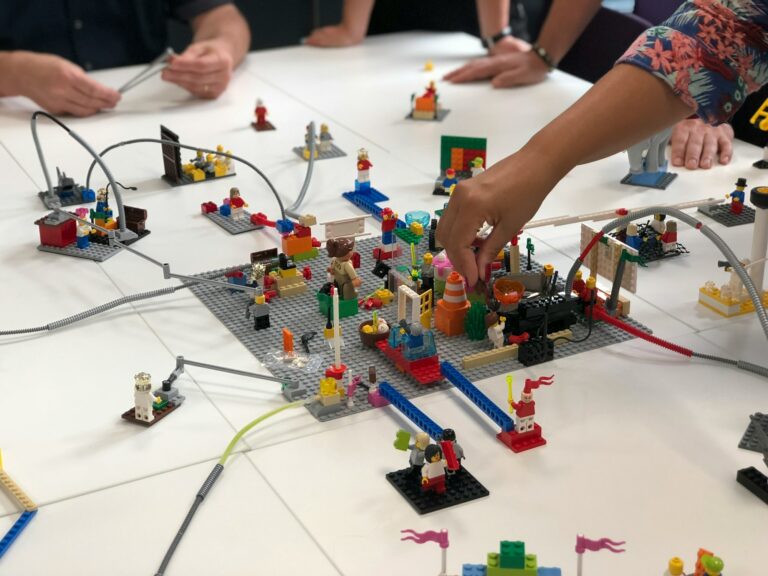#110 Der perfekte Artikel! Das Storm Projekt von Stanford
Worum geht es in diesem Artikel?
Das Storm Projekt von Stanford revolutioniert die Content-Erstellung. Ich zeige in dem Blog Beitrag die Grundlagen von Strom und die Ergebnisse an Hand eines praktischen Beispiels zu AI Storytelling.
Das STORM-Projekt – Revolution in der Erstellung von Wikipedia-Artikeln (das ist der erste Anwendungsfall)
In der heutigen Zeit ist die Fähigkeit, umfassende und genaue Informationen schnell zu sammeln und zu organisieren, wichtiger denn je. Das STORM-Projekt, entwickelt an der Stanford-Universität, stellt eine bahnbrechende Entwicklung in der Nutzung von großen Sprachmodellen für die Erstellung von Wikipedia-ähnlichen Artikeln dar. Mit dem Ziel, die komplexe Vorarbeit des Schreibprozesses zu automatisieren, bietet STORM eine innovative Lösung für die Herausforderungen, die mit der Generierung von langen, fundierten Artikeln verbunden sind.
Storm wurde entwickelt von
@inproceedings{shao2024assisting,
title={{Assisting in Writing Wikipedia-like Articles From Scratch with Large Language Models}},
author={Yijia Shao and Yucheng Jiang and Theodore A. Kanell and Peter Xu and Omar Khattab and Monica S. Lam},
year={2024},
booktitle={Proceedings of the 2024 Conference of the North American Chapter of the Association for Computational Linguistics: Human Language Technologies, Volume 1 (Long and Short Papers)}
}
Fünf Gründe, warum das STORM-Projekt besonders interessant ist:
- Automatisierte Recherche: STORM modelliert den Prozess der Themenerkundung durch multiperspektivisches Fragen stellen (ziemlich genial, aus verschiedenen Perspektiven wird auf die Research Frage geschaut, ich zeige die Perspektiven weiter unten im Artikel am Beispiel eines Artikels über AI Storytelling), was traditionelle Recherche Methoden revolutioniert.
- Verbesserung der Artikelqualität: Durch die Einbindung von Expertenfeedback und qualitativen Bewertungen hat sich gezeigt, dass STORM-Artikel in Bezug auf Umfang und Organisation traditionellen Methoden überlegen sind.
- Einsatz von KI in der Bildungspraxis: Das Projekt zeigt, wie künstliche Intelligenz genutzt werden kann, um akademische Schreibfähigkeiten zu fördern und den Bildungsprozess zu unterstützen.
- Reduktion des Zeitaufwands: STORM reduziert den Zeitaufwand und die Expertenstunden, die für das Verfassen umfangreicher Exposés erforderlich sind, erheblich.
- Förderung von Objektivität: Durch die Nutzung von vertrauenswürdigen Quellen und die Vermeidung von Internetverzerrungen trägt STORM dazu bei, objektivere und neutralere Artikel zu erstellen.
Download des wissenschaftlichen Artikels

Das STORM-System von der Stanford-Universität nutzt eine neuartige Methode, um die Recherche und Strukturierung von umfangreichen, Wikipedia-ähnlichen Artikeln zu revolutionieren. Eine Kernkomponente dieses Systems ist die Nutzung von multiperspektivischem Fragenstellen, um eine tiefergehende und breiter gefächerte Datenerhebung zu gewährleisten. Hier erläutere ich genauer, wie STORM unterschiedliche Perspektiven in seine Forschung integriert und welche Perspektiven typischerweise angenommen werden.
Multiperspektivisches Fragen stellen im STORM-Projekt
STORM zielt darauf ab, die Vorbereitungsphase des Schreibens zu automatisieren, indem es relevante Informationen aus dem Internet sammelt und strukturiert. Hierbei werden unterschiedliche Perspektiven genutzt, um den Rechercheprozess zu bereichern und eine umfassende Gliederung für den Artikel zu erstellen.
Integration verschiedener Perspektiven
- Entdeckung verschiedener Perspektiven: Zu Beginn des Prozesses identifiziert STORM verschiedene relevante Perspektiven zum Thema, indem es verwandte Artikel und deren Inhaltsverzeichnisse analysiert. Dies geschieht automatisch durch das Durchsuchen von bestehenden Wikipedia-Artikeln und anderen verlässlichen Quellen.
- Perspektivengeleitetes Fragenstellen: Basierend auf den ermittelten Perspektiven stellt STORM gezielte Fragen. Diese Perspektiven dienen als Filter oder Linse, durch die spezifische Aspekte des Themas beleuchtet werden. Beispielsweise könnte eine ökonomische Perspektive Fragen zur Finanzierung und zum Budget eines Ereignisses hervorheben, während eine sozialwissenschaftliche Perspektive auf die gesellschaftlichen Auswirkungen oder historische Bedeutung abzielen könnte.
Beispiele für angenommene Perspektiven
- Ökonomische Perspektive: Fragen nach Kosten, Budgets, wirtschaftlichen Auswirkungen etc.
- Sozialwissenschaftliche Perspektive: Untersuchung sozialer Strukturen, historischer Kontexte, demographischer Daten.
- Technische Perspektive: Fokus auf die technologische Implementierung oder Innovationen innerhalb des Themas.
- Umweltperspektive: Berücksichtigung ökologischer Auswirkungen oder Nachhaltigkeitsfragen.
- Kulturelle Perspektive: Erkundung kultureller Einflüsse, Identitäten und künstlerischer Aspekte.
Diese Perspektiven ermöglichen es STORM, präzisere und tiefere Fragen zu stellen, die über einfache „Wer“, „Was“, „Wann“ und „Wo“ Anfragen hinausgehen. Sie fördern das Entdecken vielschichtiger Informationen und tragen dazu bei, dass der endgültige Artikel eine reiche Vielfalt an Sichtweisen und Informationen widerspiegelt.
Vorteile des multiperspektivischen Ansatzes
Der Einsatz von multiperspektivischem Fragenstellen im STORM-Projekt führt zu mehreren bedeutenden Vorteilen:
- Erhöhte Objektivität und Ausgewogenheit: Durch die Berücksichtigung verschiedener Perspektiven wird eine einseitige Darstellung des Themas vermieden.
- Tiefere und umfassendere Recherche: Die Fähigkeit, spezifische und detaillierte Informationen zu erfragen, führt zu einer gründlicheren und detailreicheren Datensammlung.
- Anpassungsfähigkeit und Flexibilität: Das System kann auf neue Themen und sich ändernde Informationslandschaften schnell reagieren, indem es die relevantesten Perspektiven für die Recherche auswählt.
Das STORM-Projekt illustriert eindrucksvoll, wie moderne KI-Technologien genutzt werden können, um den Prozess der akademischen und informativen Artikelproduktion zu verbessern. Durch die Integration verschiedener Perspektiven in die Vorbereitungsphase des Schreibprozesses wird die Erstellung von Artikeln nicht nur effizienter, sondern auch umfassender und ausgewogener.
Welches Problem löst das STORM-Projekt?
Das Hauptproblem, das das STORM-Projekt adressiert, ist die Komplexität und der Zeitaufwand, die mit der Erstellung gut recherchierter, tief gehender und strukturierter Artikel verbunden sind, wie sie für Plattformen wie Wikipedia benötigt werden. Traditionelle Ansätze erfordern umfangreiche manuelle Recherchen und das Erstellen von Gliederungen vor dem eigentlichen Schreibprozess. STORM automatisiert diese vorbereitenden Schritte und ermöglicht es Autoren, effizienter und fundierter Inhalte zu erstellen, was besonders in Bildungskontexten von großer Bedeutung ist.
Das STORM-Projekt steht beispielhaft für die fortschrittliche Anwendung von KI in der akademischen und informativen Schreibpraxis, indem es nicht nur die Art und Weise, wie Artikel erstellt werden, verändert, sondern auch die Qualität und Effizienz des Schreibprozesses erheblich verbessert.

Wer noch mehr wissen möchte, dieses youtube Video ist auch sehr interessant
Meine Erfahrung
Der erste Test sollte ein Artikel über AI und Storytelling sein. Dazu habe ich Storm nach der Anleitung auf Github installiert. Das dauerte keine 15 min. Der Aufwand war einen API-Key bei you.com zu installieren. Ich hatte einen Typo-Fehler im API-Key und die Autoren haben mir direkt geholfen den Fehler zu lokalisieren.
Der Storm Prozess hat zwei Ebenen:
- Research
- Artikel schreiben
Research
Der Research Prozess geht sehr schnell über diesen Befehl: „python -m scripts.run_prewriting –input-source console –engine gpt-4 –max-conv-turn 5 –max-perspective 5 –do-research“ darauf hin fragt das Programm welches Thema man untersuchen möchte.

Writing
Ein einfacher Befehl der nachfragt worüber man schreiben möchte und der Artikel wird erstellt. Vorher braucht es natürlich einen Research über das Thema.
Ich habe den Test mit einem Artikel über AI Storytelling gemacht. Bevor ich auf den Wikipedia Artikel eingehe, möchte ich die fiktiven Agenten vorstellen die mit ihren Fragen mitgeholfen haben den Text zu erstellten. Die Conversation Log könnt ihr hier downloaden. Die Log zu lesen ist ziemlich spannend.
Die Perspektiven zum AI Storytelling
- Basic fact writer: Fokussiert darauf, die grundlegenden Fakten zum Thema abzudecken.
- AI Expert: Bringt Fachwissen zu den technischen Aspekten von KI ein, wie Natural Language Processing, Deep Learning und Generative AI, insbesondere in Bezug auf Storytelling.
- Storytelling Specialist: Trägt Erkenntnisse zur Geschichte und aktuellen Praktiken des Storytellings bei, sowie zu verschiedenen Erzählstrukturen und deren Auswirkungen auf Narrative.
- Computational Narrative Researcher: Bietet eine Perspektive darauf, wie KI zur Generierung, Analyse und Interpretation von Geschichten genutzt werden kann.
- AI in Fiction Enthusiast: Liefert eine Sichtweise darauf, wie KI in der Fiktion dargestellt wird, einschließlich utopischer und dystopischer Visionen, Mensch-KI-Beziehungen und ethischer Implikationen.
Outline von Storm erstellt

Fazit
Mit Storm werden wir viele neue Content-Generatoren erleben, die in minutenschnelle (ca. 5 min für den ganzen Prozess) umfangreiche Research Aufgaben und Überblicke generieren! Weiter gedacht, das ganze menschliche Wissen auf den berühmten „Information at your Fingertips“ von Bill Gates. Zu meinen Aufgaben werde ich mir in Zukunft erstmal einen Überblick mit Storm verschaffen. Die Ergebnisse sind aus „Default“ Einstellungen, ich bin gespannt, welche Parameter einzustellen sind.
Historical Background
The evolution of storytelling has been significantly influenced by technological advancements throughout history. From the earliest cave paintings to modern blockbuster films, each new technology has expanded the horizons of storytelling, allowing us to share our experiences, beliefs, and values in increasingly complex and engaging ways[9]. One of the most transformative technologies to impact storytelling in recent years is artificial intelligence (AI).
The concept of AI, or the endeavor to create machines that can behave in ways that would be considered intelligent if a human were so behaving, has a rich history that dates back centuries. While the modern field of AI research was formally established in the mid-20th century, the seeds of the idea were planted much earlier[1]. Philosophers and scientists have long been fascinated by the possibility of creating artificial beings endowed with human-like intelligence, a pursuit that reflects our deep-seated desire to understand what makes us human and how we can replicate those qualities in machines.
In the realm of storytelling, AI has begun to play a pivotal role. AI-based storytelling technology, which leverages artificial intelligence to create compelling narratives and characters, is becoming increasingly popular in the entertainment industry. This technology offers the possibility of crafting unique and engaging stories that can be personalized for individual users, heralding a new era of interactive and immersive storytelling experiences[7].
The development of AI storytelling technologies has been bolstered by significant milestones in AI research and application. For example, the emergence of machine learning and natural language processing has enabled computers to analyze vast amounts of data related to storytelling metrics, audience preferences, and performance metrics. This allows for the creation of narratives that are informed by a deep understanding of what makes stories successful and engaging[2][3]. Furthermore, tools like Creative Reality Studio and NovelAI showcase the potential of AI to assist in the visualization and generation of characters and scenes, further blurring the lines between human creativity and machine assistance[4][5].
As AI continues to evolve, its integration into storytelling practices is expected to deepen, enabling new forms of narrative experimentation and audience engagement. However, the successful adoption of AI in storytelling also hinges on the ability to create systems that are transparent, explainable, and trustworthy. The development of explainable AI (XAI) aims to address these concerns by making AI’s decision-making processes more understandable and accountable, thereby ensuring that the stories generated by AI are both compelling and ethically produced[6][8].
Evolution of AI Storytelling
The evolution of AI storytelling reflects a significant advancement in the use of artificial intelligence within the realm of creative writing and narrative generation. This technological progression has transformed how stories are conceived, developed, and shared, marking a new era in the entertainment industry and beyond.
Beginnings and Early Innovations
The concept of AI storytelling began as an ambitious vision to leverage technology for crafting narratives. Initially, these attempts were basic, focusing on generating short, coherent pieces of text. However, as AI technologies such as natural language processing (NLP) and machine learning (ML) matured, the capabilities of AI storytelling expanded[7]. The release of the film „Sunspring“ in 2016, written entirely by an AI bot, exemplified an early but notable milestone in AI’s potential to generate creative content. Although received with mixed reactions, „Sunspring“ sparked discussions about the future role of AI in storytelling[10].
Advancements in Technology
The field has seen rapid advancements thanks to the development of more sophisticated AI models. Technologies such as deep learning, convolutional neural networks (CNNs), and recurrent neural networks (RNNs) have enabled NLP systems to ‚learn‘ from vast volumes of data, significantly improving the quality and complexity of generated narratives[14]. These improvements have not only made the stories more coherent but also more adaptable to user preferences, creating a personalized storytelling experience[7].
Application in Various Industries
As AI storytelling technology has evolved, its applications have broadened beyond traditional entertainment mediums such as films and literature. In the gaming industry, AI has been used to create dynamic storylines that adapt to the choices of the player[7]. In marketing, AI-generated narratives have been employed to create unique brand stories and content that engages consumers on a more personal level[13]. Moreover, the educational sector has begun exploring AI storytelling as a tool for creating immersive learning experiences[7].
The Role of AI Storytelling Tools
Tools like NovelAI have emerged, offering creative writers and enthusiasts the ability to generate stories, plots, and characters across various genres. These platforms utilize AI models trained on vast literature databases to provide users with tailored story generation, making the process more accessible to individuals without formal writing experience[11][12]. NovelAI, for example, has introduced features like Lorebook for story ideation and Text Adventure for interactive story creation, highlighting the growing versatility of AI storytelling tools[11].
Future Prospects
The future of AI storytelling appears promising, with ongoing research and development aimed at further enhancing the technology’s creativity and emotional intelligence. The goal is to achieve AI that can not only construct engaging narratives but also understand and evoke the full spectrum of human emotions, making stories even more relatable and impactful[7]. As AI continues to evolve, it is expected that its role in storytelling will only become more significant, offering unprecedented opportunities for personalized and interactive narratives.
Technology Behind AI Storytelling
The foundation of AI-based storytelling lies in a combination of Natural Language Processing (NLP), Machine Learning (ML), and sometimes, Natural Language Generation (NLG). These technologies work in tandem to enable computers to understand, interpret, and generate human-like text, paving the way for AI to craft compelling narratives.
Natural Language Processing (NLP)
NLP is a critical component of AI storytelling, as it allows the system to analyze and understand human language[14][18]. This technology parses the structure and meaning of the text, enabling it to comprehend the intricacies of language, including grammar, sentiment, and even the cultural nuances embedded within the narrative[16]. Natural Language Understanding (NLU), a subset of NLP, further refines this process by interpreting the intent and meaning behind sentences, allowing AI systems to produce more nuanced and contextually relevant stories[18].
Machine Learning (ML)
Machine Learning is the engine that drives AI storytelling, enabling systems to learn from vast datasets of text and improve over time[2]. By analyzing thousands of stories, from commercially successful to unsuccessful ones, AI algorithms can identify patterns, styles, and elements that resonate with audiences. This analysis informs the generation of new narratives that are both creative and engaging[17][2]. Techniques like Deep Learning, employing Convolutional Neural Networks (CNNs) and Recurrent Neural Networks (RNNs), allow these systems to process and generate complex narratives by learning from the data they’re fed, without explicit programming for each new story[14].
Explainable AI (XAI)
A newer aspect of AI storytelling technology is the incorporation of Explainable AI, which ensures that the decisions made by the AI during the story generation process are transparent and understandable[19][20]. This is crucial for creators who need to understand how and why certain narrative elements were suggested or modified by the AI. Explainable AI techniques are applied across all steps of the ML lifecycle, from data analysis to post-modeling explanations[20].
Natural Language Generation (NLG)
NLG complements NLP by turning structured information into human-like text[14]. In the context of AI storytelling, NLG is what enables the system to actually write the story, transforming the insights and narrative structures identified by ML and NLP into coherent, engaging text. This technology ensures that the stories generated are not only interesting but also readable and stylistically consistent with human writing[14].
AI storytelling technologies are evolving rapidly, leveraging advances in NLP, ML, and NLG to create stories that are increasingly complex and human-like[7][15]. As these technologies continue to develop, the potential for AI to revolutionize storytelling across various mediums—from books and movies to games and interactive media—is immense. With ongoing improvements in AI’s understanding of human language and its ability to generate original content, the future of storytelling looks set to be as dynamic and innovative as the technology behind it[7][15].
Applications of AI Storytelling
AI-based storytelling is revolutionizing the way narratives are created and experienced across various industries. This technology leverages artificial intelligence to craft stories that are both compelling and tailored to individual preferences, marking a significant shift in content creation and consumption.
Entertainment Industry
In the entertainment sector, AI storytelling is making significant inroads by enabling the production of unique, engaging narratives that can be customized for different audiences. The technology is used to create virtual actors and characters, enhancing the visual storytelling in films, TV shows, and video games[7][23]. Furthermore, real-time animation powered by AI is transforming video games and virtual reality experiences, offering dynamic and immersive story environments[23].
Writing Assistance
For writers and content creators, AI storytelling tools act as invaluable assistants, providing support in various stages of the writing process. NovelAI and similar platforms offer interfaces that aid in story development, helping writers to craft narratives with little to no handholding[21][22]. These tools are equipped with features like the Lorebook, which serves as a repository for characters, settings, and plot elements, ensuring consistency and depth in storytelling[25][26][27].
Screenwriting and Script Development
AI technologies offer scriptwriters powerful tools for enhancing the writing process, generating new ideas, and improving script quality. AI scriptwriting tools are beneficial not only for writers but also for directors, producers, and other stakeholders in the film industry, aiding in character and plot development[29][30]. For example, StoryFit’s AI engine provides early insights into screenplay drafts, analyzing story elements, themes, character traits, and emotional intensity to guide the creative process from acquisition to marketing[23][24].
Interactive Storytelling
Interactive storytelling and text adventures represent another innovative application of AI storytelling, with platforms like NovelAI allowing users to collaborate in story creation. These features enable a participatory narrative experience, where users can directly influence the story’s direction, making each storytelling journey unique[11].
Marketing and Advertising
In the realm of marketing and advertising, AI-powered writing tools like Writecream are utilized to generate engaging story-based content. This content can range from story intros and outlines to complete narratives that align with a brand’s marketing strategy, helping businesses connect with their audience on a more personal level[28].
Character Development and Analysis
AI storytelling technologies also offer advanced capabilities for character analysis and development. Platforms analyze characters within scripts to score them based on their traits and impact levels, providing insights that enrich character portrayal and ensure consistent character presence throughout a narrative[3][17][31]. This analytical approach supports the creation of dynamic roles and effective lead characters, crucial for compelling storytelling.
Challenges and Considerations
The evolution of AI in storytelling brings forth an array of challenges and considerations that need to be addressed to harness its full potential while mitigating ethical, legal, and creative risks.
Ethical Concerns
One of the most significant challenges in AI-generated storytelling lies in navigating the ethical landscape. A primary concern is the potential for AI to perpetuate existing societal biases[9][35]. These systems learn from vast amounts of data that may contain inherent biases, leading to stories that inadvertently reinforce stereotypes or harmful norms. Addressing this requires careful evaluation and mitigation strategies to ensure fairness and inclusivity[9].
Transparency and accountability also emerge as crucial ethical considerations[9]. Stakeholders must understand how AI systems make decisions and generate narratives. This understanding is essential for assessing the implications of AI storytelling and ensuring it aligns with ethical standards.
Legal Implications
The legal implications of AI in storytelling are complex and evolving[34][36]. Questions of copyright and intellectual property rights are at the forefront, challenging traditional notions of authorship and ownership. As AI capabilities expand, so do concerns about job displacement and the rights of creators versus the technology that generates content[34][36]. Developing a new framework of ethics and law around AI in creativity is essential to address these concerns and protect the interests of all parties involved.
Creative Considerations
While AI has the potential to revolutionize storytelling by generating complex plots and characters, it raises questions about the future of human creativity[9]. There is a debate on whether AI will complement human creativity or compete with it[33]. The concern is that AI could undermine the value of human creativity, reducing the unique human quality of storytelling to something that can be replicated by machines[32].
Navigating Technological Change
As technology continues to evolve, so too does the landscape of storytelling. Creativity, often considered a uniquely human trait, faces new challenges in the era of generative AI[32]. Balancing the benefits of AI in enhancing storytelling while preserving the irreplaceable elements of human creativity is a delicate task.
Addressing Data Privacy
With the increasing use of AI, data privacy becomes a critical concern[35][37]. Developers must ensure that personal identifiable information (PII) is protected and that models comply with data privacy regulations like GDPR. This is crucial for maintaining trust and aligning AI storytelling with ethical and legal standards.
Case Studies and Notable Projects
Sunspring: A Glimpse into AI-Generated Cinema
In 2016, the film Sunspring marked a significant milestone in the intersection of artificial intelligence and storytelling. This project was notably unique because its screenplay was authored by an AI bot, showcasing the potential of machines in creative writing domains traditionally dominated by humans[10]. Set in a dystopian future, Sunspring explored themes of mass unemployment and societal disarray, engaging audiences with its novel approach and the uncanny creativity of AI. Despite its mixed reception, with some viewers finding it amusing yet peculiar, this project raised important questions about the future role of AI in storytelling and whether machines could eventually rival human creativity in the arts[10].
NovelAI: Enhancing Creative Writing with AI
NovelAI stands out as an advanced tool aimed at revolutionizing how writers approach story generation. With its Storyteller Enables feature and AI models trained on real literature, NovelAI offers a nuanced approach to storytelling, assisting writers in ideation, plot development, and character creation across various genres including horror, history, and fantasy[11][12]. Unlike traditional writing tools, NovelAI requires active participation from the user, positioning itself as a collaborative writing assistant rather than a replacement for human creativity. This platform demonstrates the practical application of AI in supporting and enhancing the creative process, providing personalized suggestions and helping users to emulate the style of their favorite authors[21][22][12].
The Role of AI in Business Storytelling and Project Management
Storytelling in business contexts, especially in project management, has been recognized for its ability to connect dry, complex project content with stakeholders and team members on an emotional level[38]. The introduction of AI into this sphere has the potential to transform how stories are told and understood within business environments. Gartner’s prediction that data stories will become the dominant form of analytics consumption by 2025 underscores the growing importance of AI in crafting compelling narratives that can translate complex data into actionable business insights[39]. This trend towards augmented analytics illustrates the broader impact of AI on storytelling within professional settings, enhancing communication, and cooperation towards common goals[38][39].
AI and Science Fiction: Reflecting Societal Concerns
The relationship between AI storytelling and science fiction provides valuable insights into public perceptions of AI. Science fiction films often personify AI as humanoid robots or sentient machines, a portrayal that, while engaging, can obscure the more immediate and tangible risks associated with AI in the real world[40]. These narratives not only entertain but serve as reflections on societal issues, influencing public understanding and attitudes towards AI technology[41]. Through the analysis of blockbuster films and their narratives, it becomes clear that science fiction can both mirror and shape societal concerns about AI, highlighting the power of storytelling in framing the discourse around technological advancements[40][41].






